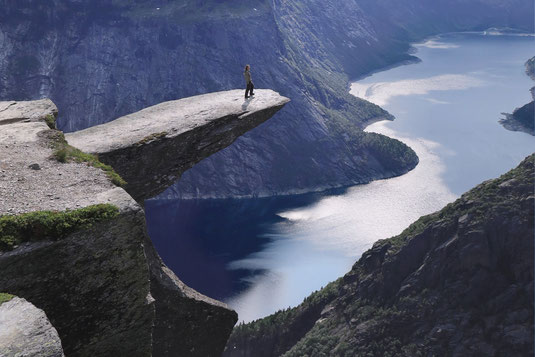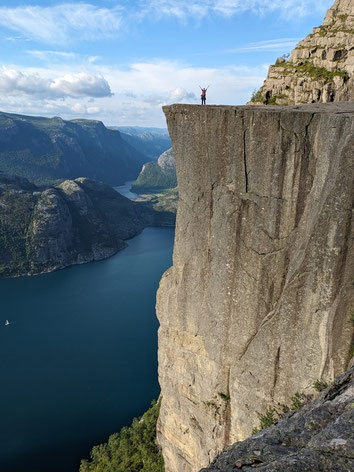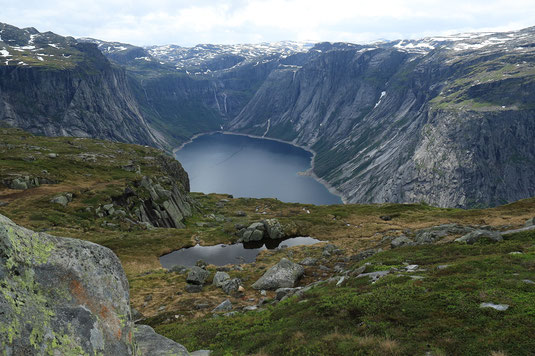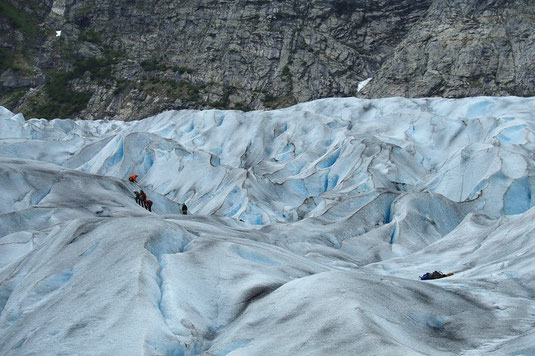On the Edge of Fjords and Glaciers – Roadtrip southern Norway.
July 22, 2023

Cool mountain air flows into my lungs as I breathe in deeply. Then I hold my breath for a long time. Goosebumps begin to rise on my arms as I slowly lie down with my belly flat on the rock. I hang my face over the cliff's edge. There is nothing. For 2300 feet downward, there is nothing. Then, at the very bottom, lies an aquamarine fjord. In the distance, I see some snowy peaks. But mostly, nothing.
I'm lying on Norway's Trolltunga—the Troll's Tongue, a large tongue-shaped outcropping. Six-mile hike to get there and a six-mile hike back. We took our trekking backpacks and spend the night in a tent on the mountaintop. But not directly on the tongue. I mean, hell no, I don't think I could sleep for a second!
Very slowly I pull myself away from the abyss into nothingness and stand up. Someday this rock tongue will break off. In ten thousand years. Or in ten minutes. Why do I have to think such shit now of all times?
We are on a road trip through the south of Norway. A land of fjords and cliffs, surreal mountain formations, and trolls. At times we get up at 3:45am to climb a pulpit rock, or camp in the wilderness, or climb a glacier with ice axes. Come with us on a journey where you keep forgetting to breathe.
Hike to Preikestolen at 3:45 a.m.

"Oh snap! Thunderstorms starting at 10 AM, and then heavy rain for the rest of the day!"
I throw my phone with the weather app against the sofa. We're in the city of Stavanger, Norway and plan to hike to the Preikestolen—the Pulpit Rock. The hike is a steep, five-mile round-trip to a cliff that rises 2000 feet straight up from the Lysefjord like a piece of sliced bread. Hiking time around five hours. Or two for Norwegians.
Wherever we meet Norwegians on the trail, we get complete fantasy numbers when we ask how long the hike will take. Then they trudge past you, over six feet tall, with 200 pounds of muscle, and with only a water bottle in their hand. They pass you twice—while you sweat profusely taking a break sitting on a rock.
My boyfriend and I ponder. Then I have the idea: "Isn't it light all the time in Norway in the summer anyway? We can just get up at four and do the hike before the storm!" I'm the anti-early bird. The early bird belongs locked away with bread and water. But I really want to go on this hike. So, at 3:45 a.m., the alarm clock goes off.
Elephant rocks, cinematic sun and threatening gusts of wind

In the light of the early morning, the trees on the hills below us seem to be clad in gold leaf.
We climb over thick rocks the size of a baby elephant (Norwegians call it "small steps"). Higher and higher we go towards Preikestolen. The pulpit rock is said to be
extremely crowded during the day. Now it is five o'clock in the morning and we are almost alone. Between wooden planks lining the marshland, steep climbs, and a plateau filled
with birch trees, an incredible sight opens up ahead in the now bluish-silver light: Lysefjord lies in the headlights of countless sunbeams, refracted through a puffy blanket of
clouds. I bounce around excitedly—what a natural wonder!
As we turn the last corner, I begin to wonder if I will dare to step very close to the edge of Preikestolen. Then an icy gust of wind grabs me, and I stagger uncontrollably through the area for a second or two. I glimpse a view of the fjord water thousands of feet below me. Fortunately, my boyfriend has not seen my chaotic steps. I act as if nothing had happened, but my heart races.
My desire to stand quite spectacularly on the edge of Preikestolen has suddenly given way to my desire for quite unspectacular survival. I'm small and light, and that rock thingy looks still good enough for a photo op while I am still 10 feet from the edge.
Whew. With slightly wobbly knees, we head back down around half past seven, where we are met by a mass migration of trekking humanity hiking up the mountain. Huh, don't they have a weather app?
At ten o'clock sharp, as we slam our car door shut in the parking lot, the heavenly flood gates break loose. The early bird gets a special thank you today!
Hike to Trolltunga for an overnight campout with tent

Dark gray like a cathedral in ruins, the rock walls around Ringedalsvatnet lake appear after we wade through a
snowfield on a plateau. 12.5 miles is the round trip to Trolltunga, if you start from the highest parking lot, dubbed P3. Over 17 miles for those starting at the
lower P2. We meet a couple from Finland at P2. "Was that 18.5 miles?" the man asks.
"Nah, only 17 and a quarter," his wife replies, laughing. They do the trail in one day, from P2. Such thoughts runs with the Scandinavians. I feel like Forever
63 as we start at P3 for our two-day hike.
Even though Trolltunga is almost as touristy as Preikestolen and you sometimes must wait in line for up to two hours around lunchtime to get a solo photo on the rocky outcropping the trail is one of the most scenic and fantastic trails I've ever hiked! Glacial rocks are reflected in the infinite blue of the lake, mountains drop down into the water, craggy and gigantic like dragon legs, while fluffy wildflowers dance in the wind, and rough, rocky cliffs are covered with soft, green grass.
The Finnish couple walks past us. Twice. They wave, both times.
The view into nothingness - almost like flying

Around 3 PM we finally arrive. My feet are burning, and I could probably make smoked ham in my shoes. We pitch our tent about 100 yards from the Trolltunga behind a hill. In Norway, Everyman's Right applies, which allows you to legally camp wild almost anywhere. The love and respect for nature is part of the Norwegian identity. That's why everyone has the right by law to use nature freely—and you never see trash or filth anywhere. Impressive! It is nice to see that something like this can work.
As evening falls, the stream of day hikers disappears like crabs washed into the sea by a wave. Suddenly it is quiet at the Troll's Tongue. We leave the tent and begin to explore. We walk through the grasslands on the plateau, past glassy ponds, and nameless waterfalls, both large and small. Eventually I venture out onto the overhanging rock. Unlike at Preikestolen, there is no wind. This gives me courage. I stand on the top of the tongue, then lie down and look over the edge. down into nothingness. My gut is racing like a Porsche at three in the morning on the Autobahn. Then I sit down and let my feet dangle into the emptiness below. For a moment, it feels like flying. Like paragliding. Until I think about continental plate shift and how even the most massive mountain will not stand forever. Back to the waterfalls, back to the tent. Now into the macaroni salad.
Glacier Hike in Jostedalsbreen National Park

Speaking of geological wonders and their apocalyptic powers, ever since we were in Iceland, I've been dying to see a glacier up close and personal. You can do that in Norway at Jostedalsbreen National Park on the Nirgardsbreen glacier arm. Yippee!
Jostedalsbreen is the largest glacier on the European mainland. In the past you could climb it in
several places. Today, due to global warming, many spots have become too unstable and are simply melting away permanently. Nirgardsbreen is one of the few arms where you can still do
glacier walks.
With ice axe in hand, we get ready! Our Nepalese guide helps us don our crampons and ropes. We set off. Past a roaring river of turquoise glacier water, to the beginning of the blue, glowing, natural wonder. The ice formation looks like whipped cream in which a troll has lit blue candles. We humans appear as ants in front of the mass of ice. It's amazing how small we are and what a destructive influence we have on really big things in the world.
I feel a great sense of awe and humility as we climb the glacier. Everywhere are gaping crevasses, holes, and crunchy ice granules. “A glacier is like a river that moves very slowly,” said a plaque in the Glacier Museum in the valley below.
As we stand at the top, my gaze slowly falls over the mass of ice. How wonderful that we get to experience this. Not just from the TV or YouTube, but in real life. In all its beauty, grandeur and it elicits so many tingling emotions—first and foremost joy and gratitude.
Three other interesting places we saw in southern Norway:
Oslo
A super cosmopolitan city where you can immediately feel the motto "Come as you are" as you step
out of the train station. I have previously experienced something like this only in parts of Berlin. Particularly spectacular is the opera house, that rises from the Oslofjord
like a tipped, sunken iceberg and which you can climb on the angled roof at any time for free.
I personally did not find the Vigeland Installation in Frogner Park worth seeing, because the sculptures are all fat, fleshy-looking people made of stone—and I just don't find
people that awesome in general. How about cat sculptures?
Oslo is also home to Edvard Munch's "Scream", housed in a huge 12-story museum devoted entirely to Munch and located right next to the opera house. The exhibition was elegantly
done and totally worth seeing!
Stavanger
We only came to the town because the weather was too shitty to go hiking. A good decision! Stavanger has a wonderfully colorful downtown with street art, a small harbor, and a neighboring Old Stavanger area dating from the 18th and 19th centuries containing white wooden houses with idyllic rose gardens. Oddly enough, it was marked on the map with a word that looked like "gammel", which means something like "rotten" in German. Then I found out that the Norwegian "gamel" means "old" in English. Anyway, it is an enjoyable place to spend an afternoon.
Geirangerfjord
Simply nope. The fjord itself is truly beautiful, but no more beautiful than many other fjords we've seen. The town of Geiranger is besieged by cruise boat tourists and the clunky cruise ships ruin the view of the fjord from the town. The town itself is unspectacular. It consists mainly of souvenir stalls, ugly concrete hotels, and RV parks. Worth seeing however is the art gallery, Geiranger Galleri, where we found intense paintings of mountain landscapes. Next time I will not even go to the city but just go hiking above the fjord.
You can find more adventures from the north here:








